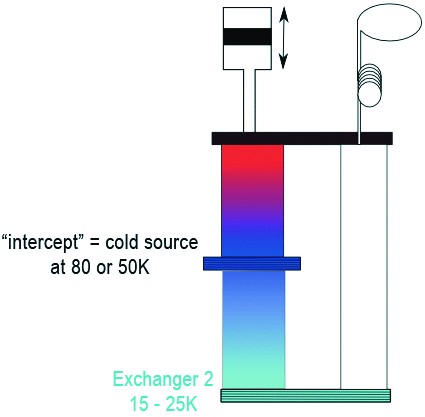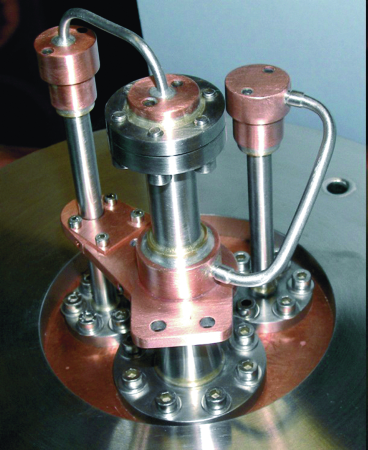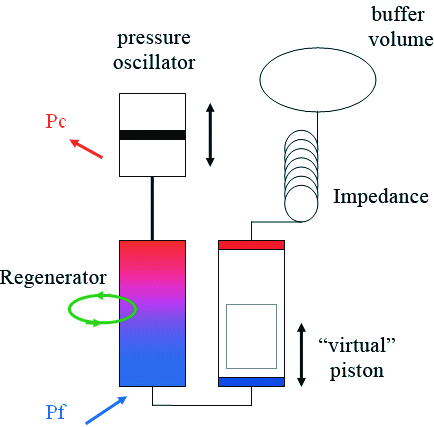Happy with our latest developments in the field of high-frequency pulse tubes designed for refrigeration in the 50 – 80 K range, the ESA (European Space Agency) appointed us to implement a new development program, in partnership with Air Liquide, with the aim being to build space-qualified cryo-coolers producing just a few mW at temperatures between 20 and 30 K. Thanks to our research, we have been able to develop various products that have now reached the industrial manufacturing stage.
Current developments are now focused on obtaining even lower temperatures as required for future space missions in the astrophysics field.
Reductions in temperature cannot be achieved simply by changing the scale of the cryo-coolers, due to the fact that several physical limitations come into play at low temperature, such as the reduction in heat capacity of the regenerator materials, or problems related to the change in helium properties. It is therefore necessary to devise multi-stage configurations which, in addition, have the advantage of focusing the development on the coldest stages. Our aim was to design a pulsed, gas tube compatible with a previously developed and space-qualified compressor generating 100 W of mechanical power.
Two architectures are described below that meet all the requirements: the first "intercepted" and the other "two-stage". In the "intercepted" configuration (Figure 1) an intermediate point of the regenerator is thermally conditioned to about 80 K by an intercept. For space missions sufficiently far away from earth, it is possible to obtain temperatures as low as 50 K by using passive radiators, which are large areas radiating their heat in the cold of space at 2.7 K. In the laboratory, this pre-cooling effect is obtained by using an additional cryo-cooler. The advantage of this architecture is that it limits regenerator losses. With this configuration, we have 300 mW of power available at 20 K. This power can be dissipated by electronic components, or by a detector, or used to pre-cool another machine. It can also be used to cool the focal plane of a telescope.

Figure 1: Diagram of the intercepted pulse tube. The cold source can be a laboratory cryo-cooler and can be replaced by a passive radiator in space.
In the "two-stage" configuration (Figure 2) operated without a conditioned thermal point or passive radiator, the first stage is designed to cool a thermal screen to 120 K. On the colder stage, it supplies 200 mW at 30 K and corresponds to ESA specifications for this operating mode. This type of machine is useful for space missions that do not benefit from a passive radiator, for example missions close to earth, or to simplify the thermal architecture.

Figure 2: Two-stage pulse tube
Following these developments, research work will be continued in order to reduce reachable temperatures even further. Next target: 15 K and sufficient cooling power to pre-cool another type of cooler, Joule-Thomson loops. These cryo-coolers are used in space astrophysics to reduce the temperature to 50 mK. For our pulse tubes, passing from 20 K to 15 K increases the above-mentioned difficulties and involves further refinements of our design.
 In outer space, it has to be high frequency
In outer space, it has to be high frequency Pulse tubes can be divided into two distinct families: "low frequency" or "high frequency". However, it is not just their operating frequencies that distinguish them (2 Hz vs. 50 Hz), but above all the technologies used to generate a pressure wave in the machine. "Low frequency" machines, which are often found in laboratories, use a helium compressor linked to a rotary valve. These machines are not suitable for space applications, owing to their excessive mass and the insufficient reliability of the compressors. "High frequency" pulsed gas tubes on the other hand have the major advantage of weighing less than 5 kg. Two opposing pistons, oscillating at approx. 50 Hz, form the "pressure oscillator". This is the only moving part in the system. The vibrations induced by this machine are therefore limited. The common denominator of the two families is the presence of a fixed regenerator, a sort of thermal sponge that enables cryogenic temperatures to be attained with relatively small pressure variations: oscillations of 1 to 2 bars with an average of 20 bars.